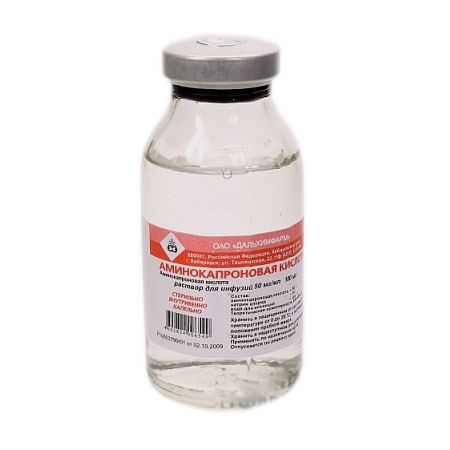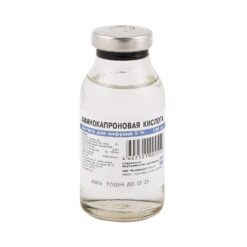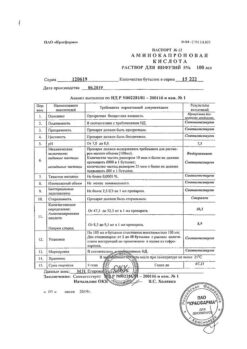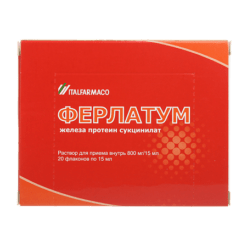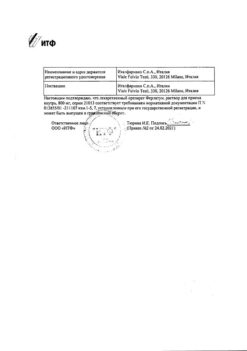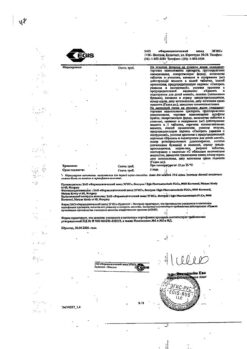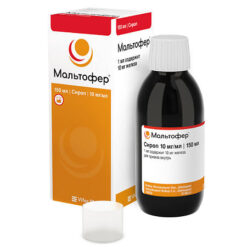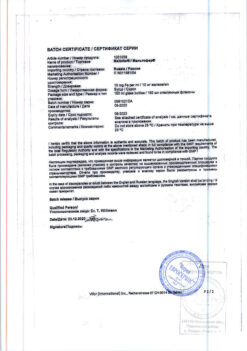No products in the cart.
Aminocaproic acid, 5%, 100 ml
€1.00
Out of stock
(E-mail when Stock is available)
Description
Aminocaproic acid promotes the process of blood clotting in bleeding associated with increased fibrinolytic activity of blood. By suppressing the action of plasminogen activators and blocking the action of plasmin, it leads to stopping bleeding.
It is also an inhibitor of kinins (biogenic polypeptides formed in the body from α-globulins under the influence of kallikrein).
It has anti-allergic effect, inhibits the formation of antibodies, increases the detoxification function of the liver and reduces capillary permeability.
Pharmacokinetics
The drug is slightly toxic. When taken orally, it is well absorbed, reaching Cmax of aminocaproic acid in the blood within 1-2 hours.
In intravenous administration the action of the drug is seen after 15-20 minutes.
The drug is quickly excreted by the kidneys – about 40-60% of the administered amount is excreted unchanged in the urine after 4 hours.
In case of impaired renal excretion, excretion of aminocaproic acid is delayed; as a result, its concentration in the blood rises sharply.
Indications
Indications
Active ingredient
Active ingredient
Composition
Composition
1 ml of infusion solution contains:
acting substance:
amincaproic acid 50 mg
How to take, the dosage
How to take, the dosage
The solution of aminocaproic acid is administered intravenously.
In adults, the drug is administered intravenously as a 5% solution in an amount up to 100 ml dropwise at a rate of 50-60 drops per minute (within 15-30 minutes). During the first hour, it is recommended to administer 4-5 g (80-100 ml) of the drug, and then, if necessary, 1 g (20 ml) every hour for about 8 hours or until the bleeding stops completely. In case of ongoing or repeated bleeding, injections of 5% aminocaproic acid solution should be repeated every 4 hours.
Injection of aminocaproic acid solution can be combined with infusion of glucose solution, hydrolysates and antishock solutions. In acute fibrinolysis, when the content of fibrinogen in the blood drops sharply, the administration of aminocaproic acid should be supplemented by a subsequent infusion of fibrinogen.
Interaction
Interaction
Can be combined with the administration of hydrolysates, glucose solutions (dextrose solutions), antishock solutions. In acute fibrinolysis the administration of aminocaproic acid with fibrinogen content of 2-4 g (maximum – 8 g) should be supplemented with a subsequent infusion.
Antiaggregative reduction with concomitant administration of direct and indirect anticoagulants.
No drugs should be added to the solution of aminocaproic acid.
Special Instructions
Special Instructions
The drug for intravenous administration is used only under hospital conditions!
When using aminocaproic acid solution it is necessary to check the fibrinolytic activity of the blood, intravenous administration of the drug should be performed under coagulogram control.
It is not recommended to eat fatty foods during treatment with aminocaproic acid.
Injection of the drug in case of hematuria is not recommended due to the risk of acute renal failure.
Contraindications
Contraindications
Side effects
Side effects
Overdose
Overdose
Worsening of side effects (dizziness, nausea, diarrhea, upper respiratory tract catarrh) and acute inhibition of fibrinolysis.
In cases of overdose, plasminogen activators (streptokinase, urokinase or anistreptase) should be administered urgently.
Additional information
| Weight | 0.223 kg |
|---|---|
| Shelf life | 3 years |
| Conditions of storage | In a light-protected place at 0-20 °C |
| Manufacturer | Dalkhimpharm, Russia |
| Medication form | solution for infusion |
| Brand | Dalkhimpharm |
Other forms…
Related products
Buy Aminocaproic acid, 5%, 100 ml with delivery to USA, UK, Europe and over 120 other countries.

